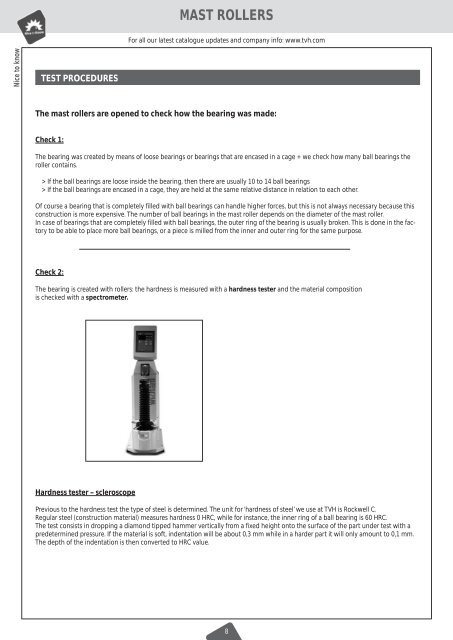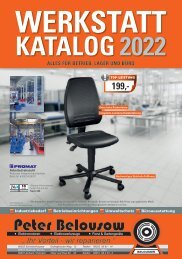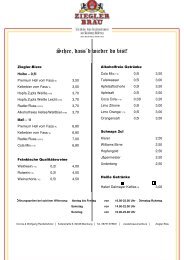Otto Schemmerer Mastrollen
Otto Schemmerer GmbH Mastrollen Katalog
Otto Schemmerer GmbH Mastrollen Katalog
- TAGS
- stapler
Erfolgreiche ePaper selbst erstellen
Machen Sie aus Ihren PDF Publikationen ein blätterbares Flipbook mit unserer einzigartigen Google optimierten e-Paper Software.
MAST ROLLERS<br />
For all our latest catalogue updates and company info: www.tvh.com<br />
Nice to know<br />
TEST PROCEDURES<br />
The mast rollers are opened to check how the bearing was made:<br />
Check 1:<br />
The bearing was created by means of loose bearings or bearings that are encased in a cage + we check how many ball bearings the<br />
roller contains.<br />
> If the ball bearings are loose inside the bearing, then there are usually 10 to 14 ball bearings<br />
> If the ball bearings are encased in a cage, they are held at the same relative distance in relation to each other.<br />
Of course a bearing that is completely filled with ball bearings can handle higher forces, but this is not always necessary because this<br />
construction is more expensive. The number of ball bearings in the mast roller depends on the diameter of the mast roller.<br />
In case of bearings that are completely filled with ball bearings, the outer ring of the bearing is usually broken. This is done in the factory<br />
to be able to place more ball bearings, or a piece is milled from the inner and outer ring for the same purpose.<br />
Check 2:<br />
The bearing is created with rollers: the hardness is measured with a hardness tester and the material composition<br />
is checked with a spectrometer.<br />
Hardness tester – scleroscope<br />
Previous to the hardness test the type of steel is determined. The unit for ‘hardness of steel’ we use at TVH is Rockwell C.<br />
Regular steel (construction material) measures hardness 0 HRC, while for instance, the inner ring of a ball bearing is 60 HRC.<br />
The test consists in dropping a diamond tipped hammer vertically from a fixed height onto the surface of the part under test with a<br />
predetermined pressure. If the material is soft, indentation will be about 0,3 mm while in a harder part it will only amount to 0,1 mm.<br />
The depth of the indentation is then converted to HRC value.<br />
8
















